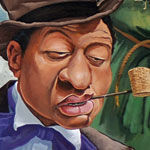
 (November 12, 1874 - March 4, 1922)
(November 12, 1874 - March 4, 1922)
Bert Williams was a popular actor, playwright, singer and dancer of musicals, plays and vaudeville. One of the most revered African American actors at the beginning of the twentieth century, Williams performed all over the world, including Broadway. Williams often performed in blackface, 1 even though he was black. Even though this helped to solidify a stereotype that was not true, it opened doors for Williams as an actor.
One of Williams's first acting jobs was in 1893 with the Martin and Selig's Minstrels, which traveled around the country. 2 It was in this troupe that Williams met and befriended George William Walker. With Walker, Williams created the comedy troupe Walker and Williams, which was renowned and successful. Walker and Williams struck out on their own in 1895 and continued working together many years. In 1903, Williams, who was the sad sack comedic character to Walker's straight man, starred on Broadway in the musical In Dahomey, the first African American musical produced on Broadway. They also performed some of the musical's numbers for King Edward VII of England in 1903, making them the first blacks to perform for the King. 3 In 1909 Walker had a stroke and could no longer perform. 4 After that, Williams set out on his own as a solo performer and began touring with a family of performers named the Keatons, including a young Buster Keaton, who once said that Bert Williams was one of his favorite comedians. 5
Williams was also known as a playwright. He co-wrote and starred in the musical play Mr. Lode of Koal, which opened in Toledo on August 29, 1909. 6 A review of this production in the Toledo Blade noted that "Mr. Williams makes the most of his part." 7 A year later, he appeared in the 1910 Ziegfeld Follies with Fanny Brice and performed in a film, now lost, which nevertheless made Williams the first major black star to be featured in a motion picture. 8 Williams continued to perform on stage, appearing in the musical Under the Bamboo Tree in 1921-1922, and to write songs until his death in March 1922. 9 Three funerals were held for Williams, with thousands of people in attendance at the one open to the public. 10
1. Krasner, 268.
2. Smith, 9.
3. Smith, xi, 73.
4. Smith 16, 113.
5. Smith 113, Sweeney, 81.
6. Hill and Hatch, 171.
7. Smith, 120.
8. Smith 143-144.
9. Smith 220, 223.
10. Smith, 225.
Resources
"Bert Williams (I)" IMDb. http://imdb.com/name/nm0930094/ 11 October 2007.
"Bert Williams." Vaudeville: Bob Hope and American Variety. http://www.loc.gov/exhibits/bobhope/images/vc26.jpg 11 October 2007.
"Bert Williams Early 1900s Minstrel Songs." http://www.besmark.com/bertwilliams.html 11 October 2007.
"Broadway, The American Musical." http://www.bbc.co.uk/bbcfour/music/ features/photogallery/broadway_photogallery2. shtml 11 October 2007.
Hill, Errol G., and James V. Hatch. A History of African American Theatre. Cambridge: Cambridge UP, 2003.
This encyclopedic resource includes a brief biography of Williams, focusing primarily on his work with George Walker. It also includes a mention of the successful musical In Dahomey.
Krasner, David. A Beautiful Pageant: African American Theatre, Drama and Performance in the Harlem Renaissance, 1910-1927. New York: Palgrave Macmillan, 2002.
Krasner writes a brief biography of Williams and Walker, and his analysis of Williams performing in blackface is meticulous.
Smith, Eric Ledell. Bert Williams: A Biography of the Pioneer Black Comedian. Jefferson, NC: McFarland and Company, 1992.
Smith's biography is exhaustive, with numerous quotes from Williams himself, as well as an appendix listing the songs that Williams wrote.
Sweeney, Kevin W, ed. Buster Keaton Interviews. Jackson: U of Mississippi P, 2007.
This book is a collection of interviews with Buster Keaton, who worked with Williams when Keaton was a young boy.